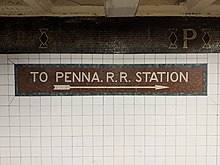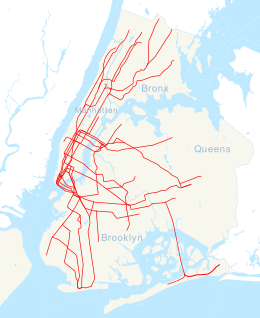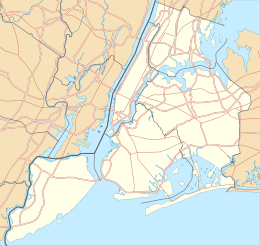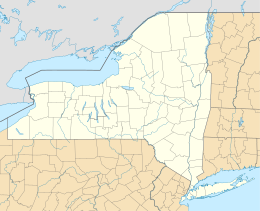railroad.wikisort.org - Station
34th Street–Penn Station is an express station on the IRT Broadway–Seventh Avenue Line of the New York City Subway. Located at the intersection of 34th Street and Seventh Avenue, it is served by the 1 and 2 trains at all times, and the 3 train at all times except late nights. Connections are available to the LIRR, NJ Transit and Amtrak at Pennsylvania Station.
34 Street–Penn Station | ||||||||||||||||||||||||||||||||||||||||||||||||||||||||||||||||||||||||||||||||||||||||||||||||
|---|---|---|---|---|---|---|---|---|---|---|---|---|---|---|---|---|---|---|---|---|---|---|---|---|---|---|---|---|---|---|---|---|---|---|---|---|---|---|---|---|---|---|---|---|---|---|---|---|---|---|---|---|---|---|---|---|---|---|---|---|---|---|---|---|---|---|---|---|---|---|---|---|---|---|---|---|---|---|---|---|---|---|---|---|---|---|---|---|---|---|---|---|---|---|---|---|
 View from northbound local platform | ||||||||||||||||||||||||||||||||||||||||||||||||||||||||||||||||||||||||||||||||||||||||||||||||
| Station statistics | ||||||||||||||||||||||||||||||||||||||||||||||||||||||||||||||||||||||||||||||||||||||||||||||||
| Address | West 34th Street & Seventh Avenue New York, NY 10001 | |||||||||||||||||||||||||||||||||||||||||||||||||||||||||||||||||||||||||||||||||||||||||||||||
| Borough | Manhattan | |||||||||||||||||||||||||||||||||||||||||||||||||||||||||||||||||||||||||||||||||||||||||||||||
| Locale | Midtown | |||||||||||||||||||||||||||||||||||||||||||||||||||||||||||||||||||||||||||||||||||||||||||||||
| Coordinates | 40.751°N 73.991°W | |||||||||||||||||||||||||||||||||||||||||||||||||||||||||||||||||||||||||||||||||||||||||||||||
| Division | A (IRT)[1] | |||||||||||||||||||||||||||||||||||||||||||||||||||||||||||||||||||||||||||||||||||||||||||||||
| Line | IRT Broadway–Seventh Avenue Line | |||||||||||||||||||||||||||||||||||||||||||||||||||||||||||||||||||||||||||||||||||||||||||||||
| Services | 1 2 3 | |||||||||||||||||||||||||||||||||||||||||||||||||||||||||||||||||||||||||||||||||||||||||||||||
| Transit | at Pennsylvania Station | |||||||||||||||||||||||||||||||||||||||||||||||||||||||||||||||||||||||||||||||||||||||||||||||
| Structure | Underground | |||||||||||||||||||||||||||||||||||||||||||||||||||||||||||||||||||||||||||||||||||||||||||||||
| Platforms | 2 side platforms (local) 1 island platform (express) | |||||||||||||||||||||||||||||||||||||||||||||||||||||||||||||||||||||||||||||||||||||||||||||||
| Tracks | 4 | |||||||||||||||||||||||||||||||||||||||||||||||||||||||||||||||||||||||||||||||||||||||||||||||
| Other information | ||||||||||||||||||||||||||||||||||||||||||||||||||||||||||||||||||||||||||||||||||||||||||||||||
| Opened | June 3, 1917[2] | |||||||||||||||||||||||||||||||||||||||||||||||||||||||||||||||||||||||||||||||||||||||||||||||
| Accessible | ||||||||||||||||||||||||||||||||||||||||||||||||||||||||||||||||||||||||||||||||||||||||||||||||
| Opposite- direction transfer | Yes | |||||||||||||||||||||||||||||||||||||||||||||||||||||||||||||||||||||||||||||||||||||||||||||||
| Traffic | ||||||||||||||||||||||||||||||||||||||||||||||||||||||||||||||||||||||||||||||||||||||||||||||||
| 2019 | 25,967,676[3] | |||||||||||||||||||||||||||||||||||||||||||||||||||||||||||||||||||||||||||||||||||||||||||||||
| Rank | 6 out of 424[3] | |||||||||||||||||||||||||||||||||||||||||||||||||||||||||||||||||||||||||||||||||||||||||||||||
| ||||||||||||||||||||||||||||||||||||||||||||||||||||||||||||||||||||||||||||||||||||||||||||||||
| ||||||||||||||||||||||||||||||||||||||||||||||||||||||||||||||||||||||||||||||||||||||||||||||||
| ||||||||||||||||||||||||||||||||||||||||||||||||||||||||||||||||||||||||||||||||||||||||||||||||
| ||||||||||||||||||||||||||||||||||||||||||||||||||||||||||||||||||||||||||||||||||||||||||||||||
| ||||||||||||||||||||||||||||||||||||||||||||||||||||||||||||||||||||||||||||||||||||||||||||||||
The station was built by the Interborough Rapid Transit Company (IRT) as part of the Dual Contracts with New York City, and opened on June 3, 1917.
History
Construction and opening
The Dual Contracts, which were signed on March 19, 1913, were contracts for the construction, rehabilitation and operation of rapid transit lines in the City of New York. The contracts were "dual" in that they were signed between the city and two separate private companies, the Interborough Rapid Transit Company (IRT) and the Brooklyn Rapid Transit Company (BRT), all working together to make the construction of the Dual Contracts possible. The Dual Contracts promised the construction of several lines in Brooklyn. As part of Contract 4, the IRT agreed to build a branch of the original subway line south down Seventh Avenue, Varick Street, and West Broadway to serve the West Side of Manhattan.[4][5][6]
The construction of this line, in conjunction with the construction of the Lexington Avenue Line, would change the operations of the IRT system. Instead of having trains go via Broadway, turning onto 42nd Street, before finally turning onto Park Avenue, there would be two trunk lines connected by the 42nd Street Shuttle. The system would be changed from looking like a "Z" system on a map to an "H" system. One trunk would run via the new Lexington Avenue Line down Park Avenue, and the other trunk would run via the new Seventh Avenue Line up Broadway. In order for the line to continue down Varick Street and West Broadway, these streets needed to be widened, and two new streets were built, the Seventh Avenue Extension and the Varick Street Extension.[7] It was predicted that the subway extension would lead to the growth of the Lower West Side, and to neighborhoods such as Chelsea and Greenwich Village.[8][9]
34th Street–Penn Station on the IRT Broadway–Seventh Avenue Line was opened on June 3, 1917, as part of an extension of the Interborough Rapid Transit Company, the dominant subway in Manhattan at the time, from Times Square–42nd Street to South Ferry.[2] It was served by a shuttle train to Times Square until the rest of the extension opened a year later on July 1, 1918.[10] This meant that the subway would be expanded down the Lower West Side to neighborhoods such as Greenwich Village and the western portion of the Financial District.
The new "H" system was implemented on August 1, 1918, joining the two halves of the Broadway–Seventh Avenue Line and sending all West Side trains south from Times Square.[11] An immediate result of the switch was the need to transfer using the 42nd Street Shuttle in order to retrace the original layout. The completion of the "H" system doubled the capacity of the IRT system.[8]
Later years
The city government took over the IRT's operations on June 12, 1940.[12][13] On August 23, 1985, the Metropolitan Transportation Authority (MTA) awarded a $2.24 million contract to rebuild the station and to double the width of the passageway to Penn Station. The project was scheduled to be completed in spring 1987.[14]
Under the 2015–2019 MTA Capital Program, the station, along with thirty-two other New York City Subway stations, underwent a complete overhaul as part of the Enhanced Station Initiative. Updates included cellular service, Wi-Fi, charging stations, improved signage, and improved station lighting. Unlike other stations that were renovated under the initiative, 34th Street–Penn Station was not completely closed during construction.[15] In January 2018, the NYCT and Bus Committee recommended that Judlau Contracting receive the $125 million contract for the renovations of 57th and 23rd Streets on the IND Sixth Avenue Line; 28th Street on the IRT Lexington Avenue Line, and 34th Street–Penn Station on the IRT Broadway–Seventh Avenue Line and IND Eighth Avenue Line.[16] However, the MTA Board temporarily deferred the vote for these packages after city representatives refused to vote to award the contracts.[17][18] The contract was put back for a vote in February, where it was ultimately approved.[19] These improvements were substantially completed by May 2019.[20]
Station layout

| G | Street level | Entrances/exits |
| B1 Platform level | ||
| Side platform | ||
| Northbound local | ← ← | |
| Northbound express | ← ← | |
| Island platform | ||
| Southbound express | | |
| Southbound local | | |
| Side platform | ||
| B2 | Mezzanine | Connector between platforms, connection to Penn Station |
Like 34th Street–Penn Station on the IND Eighth Avenue Line and Atlantic Avenue–Barclays Center on the IRT Eastern Parkway Line, this station has two side platforms for local service and a center island platform for express service. This is due to the expected increase in ridership and to encourage riders to switch at the next stop northbound, Times Square–42nd Street, as it is set up in the usual island platform manner for cross-platform interchanges.[21]
There is no free transfer between this station and the station of the same name on the IND Eighth Avenue Line, despite the fact that both connect to Penn Station. The nearest transfer location is at Times Square–42nd Street with a free transfer to 42nd Street–Port Authority Bus Terminal.[21]
| 33rd St to 34th St subway cross-section | |||||||||||
| 11th Av | 10th & 9th Avs are skipped |
Farley Building & Moynihan Train Hall |
8th Av | Madison Square Garden |
7th Av | Storefronts | 6th Av & Broadway |
5th & Madison Avs are skipped |
Park Av | ||
| mezzanine | train hall | A / C / E | concourse | 1 / 2 / 3 | Former Gimbel's passageway |
mezz | PATH | 6 / <6> | |||
| mezzanine | conc | mezzanine | concourse | mezzanine | N / Q / R / W | ||||||
| 7 / <7> | Penn Station (Platform Level) | B/D/F/<F>/M | |||||||||
Exits


34th Street–Penn Station spans three streets (32nd, 33rd, and 34th Streets) with a set of entrances/exits at all of these streets. For the purposes of this article, entrance and exit are interchangeable.[22]
There are four entrances directly from the intersection of 34th Street and Seventh Avenue. On the local platforms the turnstiles for these exits are at platform level; passengers wishing to use the express platforms must use a passageway beneath the platforms and tracks. These entrances utilize the northern portions of the platforms. There is also a supplementary and handicapped-accessible entrance to the Penn Station complex in general from 34th Street.[22]
There are three direct entrances from the street at 33rd Street and Seventh Avenue. As a replacement for the southwestern corner's lack of an entrance, there is an underground entrance directly connecting the station with the Long Island Rail Road concourse in the Penn Station complex. The turnstiles for this entrance are located below the track level and utilize the central portions of the platforms.[22]
The main entrance to the Penn Station complex is located on the western end of 32nd Street. From there, passengers may go through the New Jersey Transit and Long Island Rail Road concourses and use the entrance to this station at the end of the latter's concourse. There is also a smaller exit from the station at the southern ends of the platforms that connects with the end of the New Jersey Transit concourse where it meets the Long Island Rail Road underneath the main corridor in the station that connects New Jersey Transit and Amtrak. There is also an entrance on the north side of 32nd Street between Seventh and Sixth Avenues.[22]
Ridership
34th Street–Penn Station on the Broadway–Seventh Avenue Line is continually ranked as one of the busiest stations in the subway system. In 2016, it was the fifth-busiest subway station, with 27,741,367 riders as recorded by the Metropolitan Transportation Authority.[23] By comparison, its sister station on the Eighth Avenue Line is ranked sixth-busiest, with 25,183,869 passengers.[23] When the Broadway–Seventh Avenue Line station was a shuttle stop before the rest of the South Ferry extension opened, ridership was quite low; in its first year of operation, only 78,121 boardings were recorded.[24]
References
- "Glossary". Second Avenue Subway Supplemental Draft Environmental Impact Statement (SDEIS) (PDF). Vol. 1. Metropolitan Transportation Authority. March 4, 2003. pp. 1–2. Archived from the original (PDF) on February 26, 2021. Retrieved January 1, 2021.
- "Three New Links of the Dual Subway System Opened". New York Times. June 3, 1917. p. 33.
- "Facts and Figures: Annual Subway Ridership 2014–2019". Metropolitan Transportation Authority. 2020. Retrieved May 26, 2020.
- "Terms and Conditions of Dual System Contracts". nycsubway.org. Public Service Commission. March 19, 1913. Archived from the original on May 13, 2015. Retrieved February 16, 2015.
- "The Dual System of Rapid Transit (1912)". nycsubway.org. Public Service Commission. September 1912. Archived from the original on January 26, 2021. Retrieved May 30, 2017.
- "Most Recent Map of the Dual Subway System Which Shows How Brooklyn Borough Is Favored In New Transit Lines". The Brooklyn Daily Eagle. September 9, 1917. p. 37. Archived from the original on October 26, 2016. Retrieved August 23, 2016 – via Brooklyn Public Library; newspapers.com.
- Sealey, D.A. (1916). "Rapid Transit Work in New York City, 1915". Engineering News. Vol. 75, no. 18. McGraw-Hill Publishing Company. p. 846. hdl:2027/njp.32101061103816. Archived from the original on June 20, 2022. Retrieved July 28, 2021 – via HathiTrust.
- Whitney, Travis H. (March 10, 1918). "The Seventh and Lexington Avenue Subways Will Revive Dormant Sections" (PDF). The New York Times. p. 12. ISSN 0362-4331. Archived (PDF) from the original on December 12, 2019. Retrieved August 26, 2016.
- "Public Service Commission Fixes July 15 For Opening of The New Seventh and Lexington Avenue Subway Lines" (PDF). The New York Times. May 19, 1918. p. 32. ISSN 0362-4331. Archived (PDF) from the original on July 13, 2021. Retrieved November 6, 2016.
- "Open new subway to regular traffic". New York Times. Archived from the original on December 12, 2021. Retrieved August 27, 2008.
- "Open New Subway Lines to Traffic; Called a Triumph" (PDF). The New York Times. August 2, 1918. p. 1. ISSN 0362-4331. Archived (PDF) from the original on February 21, 2021. Retrieved April 21, 2020.
- "City Transit Unity Is Now a Reality; Title to I.R.T. Lines Passes to Municipality, Ending 19-Year Campaign". The New York Times. June 13, 1940. ISSN 0362-4331. Archived from the original on January 7, 2022. Retrieved May 14, 2022.
- "Transit Unification Completed As City Takes Over I. R. T. Lines: Systems Come Under Single Control After Efforts Begun in 1921; Mayor Is Jubilant at City Hall Ceremony Recalling 1904 Celebration". New York Herald Tribune. June 13, 1940. p. 25. ProQuest 1248134780.
- Gordy, Margaret (August 24, 1985). "MTA to fund Troubled Tunnels". Newsday.
- "Enhanced Station Initiative: CCM Pre-Proposal Conference" (PDF). Metropolitan Transportation Authority. October 25, 2016. p. 8 (PDF page 15). Archived (PDF) from the original on August 12, 2017. Retrieved August 11, 2017.
- "NYCT/Bus Committee Meeting" (PDF). Metropolitan Transportation Authority. January 22, 2018. p. 135. Archived from the original (PDF) on January 27, 2018. Retrieved January 19, 2018.
- Barone, Vincent (January 24, 2018). "Controversial cosmetic subway improvement plan falters". am New York. Archived from the original on October 3, 2019. Retrieved January 25, 2018.
- Siff, Andrew (January 24, 2018). "MTA Shelves Plan to Modernize Subway Stations Amid Criticism". NBC New York. Archived from the original on January 25, 2018. Retrieved January 25, 2018.
- "Foes Hit Gov's Station Fix Plan". NY Daily News. February 13, 2018. Archived from the original on February 23, 2018. Retrieved February 23, 2018.
- "NYCT/Bus Committee Meeting" (PDF). Metropolitan Transportation Authority. May 20, 2019. p. 168. Archived (PDF) from the original on May 18, 2019. Retrieved May 19, 2019.
- "34th Street-Penn Station". NYCSubway.org. Archived from the original on May 11, 2012. Retrieved August 27, 2008.
- "MTA Neighborhood Maps: Pennsylvania Station / Times Square" (PDF). mta.info. Metropolitan Transportation Authority. 2015. Archived (PDF) from the original on September 14, 2020. Retrieved December 11, 2015.
- "1904-2006 ridership figures". Metropolitan Transportation Authority. Archived from the original on July 23, 2011. Retrieved August 28, 2008.
External links
- nycsubway.org – IRT West Side Line: 34th Street/Penn Station
Другой контент может иметь иную лицензию. Перед использованием материалов сайта WikiSort.org внимательно изучите правила лицензирования конкретных элементов наполнения сайта.
WikiSort.org - проект по пересортировке и дополнению контента Википедии






